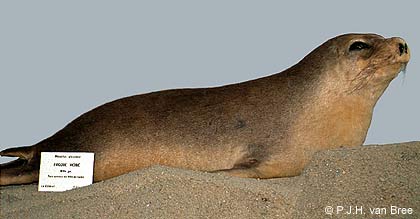

 |
||
 |
||
Vol. 5 (2): November 2002 |
Download this article
|
|
ON A YOUNG MONK SEAL THAT LOST ITS WAY IN 1927Peter J.H. van BreeZoological Museum, University of Amsterdam
|
 |
|
The 1927 Le Cormier specimen, now on display in the Natural History Museum in Nantes. |
The first, a young animal with a length of two meters, was discovered at the lower reaches of the river Gironde, northwest of the town of Bordeaux, in March 1817. The seal was mounted and exhibited in the Museum Rodrigues, but was subsequently lost when the museum closed down (Burguet 1843).
The discovery of these two monk seals poses an interesting question. Did they originate from the Mediterranean population or from the Atlantic? In her short article, Mrs J. Baudouin-Bodin, the former director of the Nantes Natural History Museum, expresses the belief that the Cormier specimen came from the Mediterranean one.
The present author, however, finds it more logical that the French Atlantic specimens originated from the Atlantic monk seal population. Despite the fact that no extralimital records of Monachus monachus are known from the Spanish Atlantic coasts and from Portugal (Teixeira 1979, Ibanez 1981, Reiner 1981), the discovery locations are closer to the Atlantic population than to the Mediterranean population. In the absence of firm evidence, however, the question of origin remains guesswork.
Another interesting aspect of the two records of monk seals on the French Atlantic coast is that so few extralimital records of Monachus monachus are known. Marine mammals which have no superable barriers can be found very far from their normal distribution range. Arctic species, for instance the hooded seal (Cystophora cristata Erxleben, 1777) can be found on the coast of Portugal and southern Spain, as well as in the Gulf of Mexico, the northern Caribbean Sea and on the coast of California. A southern elephant seal (Mirounga leonina Linnaeus, 1758), an Antarctic species, has been found on the coast of Oman on the Arabian Peninsula. Many more examples of extralimital records of seals and cetaceans can be cited, but would be beyond the scope of this short article.
The author is grateful for the help he received from the staff of the Natural History Museum at Nantes, where he could photograph the mounted Le Cormier monk seal.
Baudouin-Bodin, J. (1964). Capture de Phoque moine dans l'Atlantique. Mammalia, 28 (3): 522.
Burguet, H. (1843). Mélanges d'Histoire naturelle pour servir à la faune du Departement de la Gironde. Actes Soc. Linn. Bordeau, 13: 300-318.
Ibanez, J.M. (1981). La foca monge (Monachus monachus). Mem. Museu do Mar (Zool.), 1 (10): 1-12, 5 figs.
Reiner, F. (1981). Guia de identificaçao dos cetáceos e focas de Portugal continental, Açores e Madeira. Mem. Museu do Mar (Zool.), 1 (11): 1-59.
Teixeira, A.M.A.P. (1979). Marine mammals of the Portuguese coast. Z. Säugetierk., 44 (4): 221-238.
Copyright © 2002 Peter J.H. van Bree, The Monachus Guardian. All Rights Reserved |